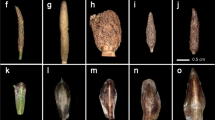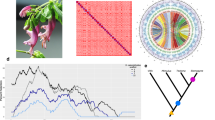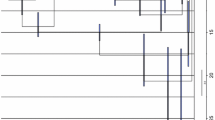Abstract
Electrophoretic data show thatPolytrichastrum pallidisetum, P. ohioense, andP. sexangulare are allopolyploids. They display fixed, heterozygous banding patterns at five to six of the 11 enzyme loci that we screened. In total, we sampled 304 populations representing three genera (Polytrichastrum, Polytrichum, andPogonatum) and 18 species in our examination of the allopolyploids and their putative haploid progenitors. There were no extant species that fit perfectly as a progenitor of any allopolyploid. BothP. pallidisetum andP. ohioense appear to have originated as intergeneric hybrids between one progenitor with aPolytrichastrum-type genome and another with aPolytrichum-type genome. The extant haploid species with the most similar genomes to the putative progenitors ofP. pallidisetum werePolytrichastrum appalachianum andPolytrichum commune, whereas forPolytrichastrum ohioense the species werePolytrichastrum formosum (orP. longisetum) andPolytrichum commune. Polytrichastrum sexangulare was genetically more similar to species ofPogonatum, as was one taxon that appears to be one of its progenitors,P. sexangulare var.vulcanicum ( =Polytrichum/Pogonatum sphaerothecium). The other progenitor also must have possessed alleles that are common in species ofPogonatum. The Polytrichaceae are a relatively ancient group of mosses, and the hybridizations that gave rise to these allopolyploids may have occurred long ago. It is likely that the genomes of the original progenitors have changed over time or that those progenitors are now extinct.
Similar content being viewed by others
References
Anderson L. E., Crum H. A., Buck W. R. (1990) List of the mosses of North America north of Mexico. Bryologist 93: 448–499.
Boisselier-Dubayle M. C., Lambourdiere J., Bischler H. (1998) The leafy liverwortPorella baueri (Porellaceae) is an allopolyploid. Plant Syst. Evol. 210: 175–197.
Cronberg N. (1996) Isozyme evidence of relationships withinSphagnum sect.Actutifolia (Sphagnaceae, Bryophyta). Plant Syst. Evol. 203: 41–64.
Crum H. A. (1976) Mosses of the Great Lakes forest. University Herbarium, University of Michigan, Ann Arbor:
Crum H. A., Anderson L. E. (1981) Mosses of eastern North America. 2 vols. Columbia University Press, New York.
Derda G. S., Wyatt R. (1990) Genetic variation in the common hair-cap moss,Polytrichum commune. Syst. Bot. 15: 592–605.
Derda G. S., Wyatt R. (1999a) Levels of genetic variation and its partitioning in the wide-ranging mossPolytrichum commune. Syst. Bot. (in press).
Derda G. S., Wyatt R. (1999b) Genetic variation and population structure inPolytrichum juniperinum andP. strictum (Polytrichaceae). Lindbergia (in press).
Derda G. S., Wyatt R. (1999c) Genetic diversity within and among populations ofPolytrichum piliferum (Polytrichaceae). J. Hattori Bot. Lab. 86: 121–135.
Derda G. S., Wyatt R., Hyvönen J. (1999) Genetic similarities among the Hair-Cap Mosses (Polytrichaceae) as revealed by enzyme electrophoresis. Bryologist 102 (in press).
Fritsch R. (1982) Index to plant chromosome numbers — bryophytes. Regnum Veg. 108: 1–268.
Frye T. C. (1937) Polytrichaceae. In: Grout A. J. (ed.) Moss flora of North America north of Mexico. Published by the author, Newfane, Vermont, pp. 99–128.
Hyvönen J. (1989) A synopsis of the genusPogonatum (Polytrichaceae, Musci). Acta Bot. Fennica 138: 1–87.
Hyvönen J., Hedderson T. A., Smith Merrill G. L., Gibbings J. G., Koskinen S. (1998) On phylogeny of the Polytrichales. Bryologist 101: 489–504.
Koponen T. (1971) A monograph ofPlagiomnium sect.Rosulata (Mniaceae). Ann. Bot. Fenn. 8: 305–367.
Koponen T., Nilsson E. (1977) Flavonoid patterns and species pairs inPlagiomnium andRhizomnium (Mniaceae). Bryophyt. Biblioth. 13: 411–425.
Kruskal J. B. (1964) Nonmetric multidimensional scaling: a numerical method. Psychometrika 29: 28–42.
Lawton E. (1971) Moss flora of the Pacific Northwest. The Hattori Botanical Laboratory, Nichinan, Japan.
Lowry R. J. (1948) A cytotaxonomic study of the genusMnium. Mem. Torrey Bot. Club 20: 1–42.
Lowry R. J. (1954) Chromosome numbers and relationships in the genusAtrichum in North America. Am. J. Bot. 41: 410–414.
Merrill G. L. Smith (1992) Notes on North American Polytrichaceae:Polytrichastrum. Bryologist 95: 270–273.
Nei M. (1972) Genetic distance between populations. Am. Nat. 106: 283–292.
Odrzykoski I. J., Chudzinska E., Szweykowski J. (1996) The hybrid origin of the polyploid liverwortPellia borealis. Genetica 98: 75–86.
Osada T. (1965) Japanese Polytrichaceae. I. Introduction and the genusPogonatum. J. Hattori Bot. Lab. 28: 171–201.
Osada T. (1966) Japanese Polytrichaceae. II. The generaPolytrichum, Oligotrichum, Bartramiopsis, andAtrichum and phytogeography. J. Hattori Bot. Lab. 29: 1–52.
Rohlf F. J. (1992) NTSYS-PC, Numerical taxonomy and multivariate analysis system. Exeter Publishing, New York.
Smith G. L. (1971) A conspectus of the genera of Polytrichaceae. Mem. New York Bot. Gard. 21: 1–83.
Smith G. L. (1972) Continental drift and the distribution of the Polytrichaceae J. Hattori Bot. Lab. 35: 41–49.
Watson E. V. (1971) The structure and life of bryophytes. Hutchinson University Library, London.
Whitkus R. (1988) Modified version of GENESTAT: A program for computing genetic statistics and allelic frequency data. Plant Genetics Newsletter 4: 10.
Wyatt R., Anderson L. E. (1984) Breeding systems in bryophytes. In: Dyer A. F., Duckett J. G. (eds.) The experimental biology of bryophytes. Academic Press, London, pp. 39–64.
Wyatt R., Derda G. S. (1997) Population biology of the Polytrichaceae. Adv. Bryol. 6: 265–295.
Wyatt R., Odrzykoski I. J. (1998) On the origins of the allopolyploid mossPlagiomnium cuspidatum. Bryologist 101: 263–271.
Wyatt R., Stoneburner A. (1984) Biosystematics of bryophytes: an overview. In: Grant W. F. (ed.) Plant biosystematics. Academic Press. Toronto, pp. 519–542.
Wyatt R., Odrzykoski I. J., Stoneburner A. (1992) Isozyme evidence of reticulate evolution in mosses:Plagiomnium medium is an allopolyploid ofP. ellipticum ×P. insigne. Syst. Bot. 17: 532–550.
Wyatt R., Odrzykoshi I. J., Stoneburner A. (1993a) Isozyme evidence regarding the origins of the allopolyploid mossPlagiomnium curvatulum. Lindbergia 18: 49–58.
Wyatt R., Odrzykoshi I. J., Stoneburner A. (1993b) Isozyme evidence proves that the mossRhizomnium pseudopunctatum is an allopolyploid ofR. gracile ×R. magnifolium. Mem. Torrey Bot. Club 25: 20–34.
Wyatt R., Odrzykoshi I. J., Stoneburner A., Bass H. W., Galau G. A. (1988) Allopolyploidy in bryophytes: Multiple origins ofPlagiomnium medium. Proc. Natl. Acad. Sci. U.S.A. 85: 5601–5604.
Author information
Authors and Affiliations
Rights and permissions
About this article
Cite this article
Derda, G.S., Wyatt, R. Isozyme evidence regarding the origins of three allopolyploid species ofPolytrichastrum (Polytrichaceae, Bryophyta). Pl Syst Evol 220, 37–53 (2000). https://doi.org/10.1007/BF00985369
Received:
Accepted:
Issue Date:
DOI: https://doi.org/10.1007/BF00985369




